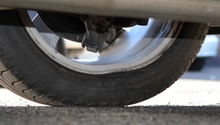Acura TSX 2004-2014: Tires General Information and Specs
Whether you're in the market for new tires for your Acura TSX, or you are just curious about your tires, read on to learn some general information about them.
This article applies to the Acura TSX (2004-2014).
Every car owner will need to purchase tires at some point of their lives. If your Acura TSX needs new tires, or if you're just curious about learning some information on keeping your tires going for a long time, this guide will help you with anything that you need regarding your tires. Before going to the tire shop and asking them if you're due for new tires, read the guide below to learn everything you need to know and how to keep them healthy.

Tire Size
Tire size can vary by the year of your TSX. However, there is a much better way to figure out your tire size than to play the guessing game. The first place to figure out the tire size is on the tires themselves. Each tire will have the size written on it, so if you're ever wondering about the size your car has been rocking, it's right there for you. The second place is in the driver's door jamb; on the placard you will find the recommended tire sizes for your car. So even if you have the wrong tires on, you can still figure out the ideal size on that placard. Note that if the previous owner has changed the rims, the recommended tire sizes are no longer valid.

Tire PSI
Maintaining a proper, even tire pressure in all four of your tires can save you some tire tread, which translates into saving money. Uneven tire pressure can affect various parts of your car, from your tire tread, shocks, to even your handling. The tire pressure can change due to weather temperature changes. So if you're having a really hot week, your tires could inflate more, and if you're having a cold one, your tires could deflate. It's good to check the tire pressure once a week, or when the weather changes. To find the proper tire pressure, you can check the same two locations we mentioned above: on the tires themselves or on the placard in the driver's door jamb.

Tire Wear
Tire wear is inevitable, but there are ways to reduce it as much as you can. Proper alignment can end up saving you hundreds of dollars on tires, because if your car is misaligned, you can wear your tires unevenly much faster. Even tire pressure can ensure your tires last a few thousand miles longer.
On a site note, if you have worn suspension components, your tires can wear prematurely. So always replace your shocks and bushings when you need to.
Make it a habit to visually inspect each tire once a month. Check the far end of the tire, towards the wheel well, and check the outer side. Any uneven wear can indicate misalignment, over inflation, under inflation, non-balanced tires, and a series of other issues.

Related Discussions
- Tire Selection - Acurazine.com
- Stock Rims - Acurazine.com






